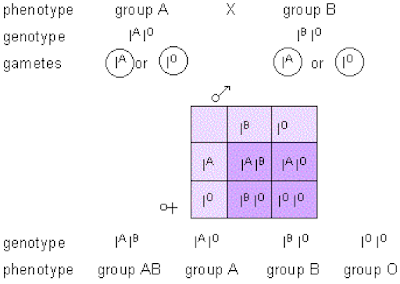 Patterns of inheritance are explained by using genetic diagrams. Genetic diagrams are the standard way of showing the genotypes of offspring that might be expected from 2 parents.
Patterns of inheritance are explained by using genetic diagrams. Genetic diagrams are the standard way of showing the genotypes of offspring that might be expected from 2 parents.In sexual reproduction, haploid gametes are made following meiosis. Each gamete contains 1 pair or chromosomes = one copy of each gene.
Monohybrid inheritance: inheritance of 1 gene
Sex linkage - a sex linked gene is a gene that is present on the X chromosome and not the Y chromosome
e.g.: colour blindness
Dihybrid inheritance: inheritance of 2 genes
Independent assortment of homologous chromosomes during meiosis I results in a variety of genotypes in the gametes formed.

ratio 9 : 3 : 3 : 1 of dihybrid cross between 2 heterozygotes
- alleles of both genes show complete dominance
- genes are on different chromosomes
Interactions between loci - where different loci interact to affect one phenotypic character
e.g.: alleles on 2 separate loci both affect the colour of feathers on a bird
Autosomal linkage
Genes are linked when two or more genes are present on the same chromosome => they tend to be inherited together and do not assort independently.
e.g.: Drosophila colour gene and shape gene
Body colour gene:
- E = allele for striped body
- e = allele for ebony body
Antennal shape gene:
- A = allele for normal antennae
- a = allele for aristopedia antennae
EEAA = genes not on same chromosome
(EA)(EA) = genes on the same chromosome
- Parental genotype (EA)(EA) => gametes EA only
- Parental genotype (EA)(ea) => gametes EA or ea
- Parental genotype (ea)(ea) => gametes ea only
16.2 The roles of genes in determining the phenotype Studies of human genetic conditions have revealed the links between genes, enzymes and the phenotype. a) explain the terms gene, locus, allele, dominant, recessive, codominant, linkage, test cross, F1 and F2, phenotype, genotype, homozygous and heterozygous b) use genetic diagrams to solve problems involving monohybrid and dihybrid crosses, including those involving autosomal linkage, sex linkage, codominance, multiple alleles and gene interactions (the term epistasis does not need to be used; knowledge of the expected ratio for various types of epistasis is not required. The focus is on problem solving) c) use genetic diagrams to solve problems involving test crosses d) use the chi-squared test to test the significance of differences between observed and expected results (the formula for the chi-squared test will be provided) (see Mathematical requirements) e) explain that gene mutation occurs by substitution, deletion and insertion of base pairs in DNA and outline how such mutations may affect the phenotype f) outline the effects of mutant alleles on the phenotype in the following human conditions: albinism, sickle cell anaemia, haemophilia and Huntington’s disease g) explain the relationship between genes, enzymes and phenotype with respect to the gene for tyrosinase that is involved with the production of melanin |















